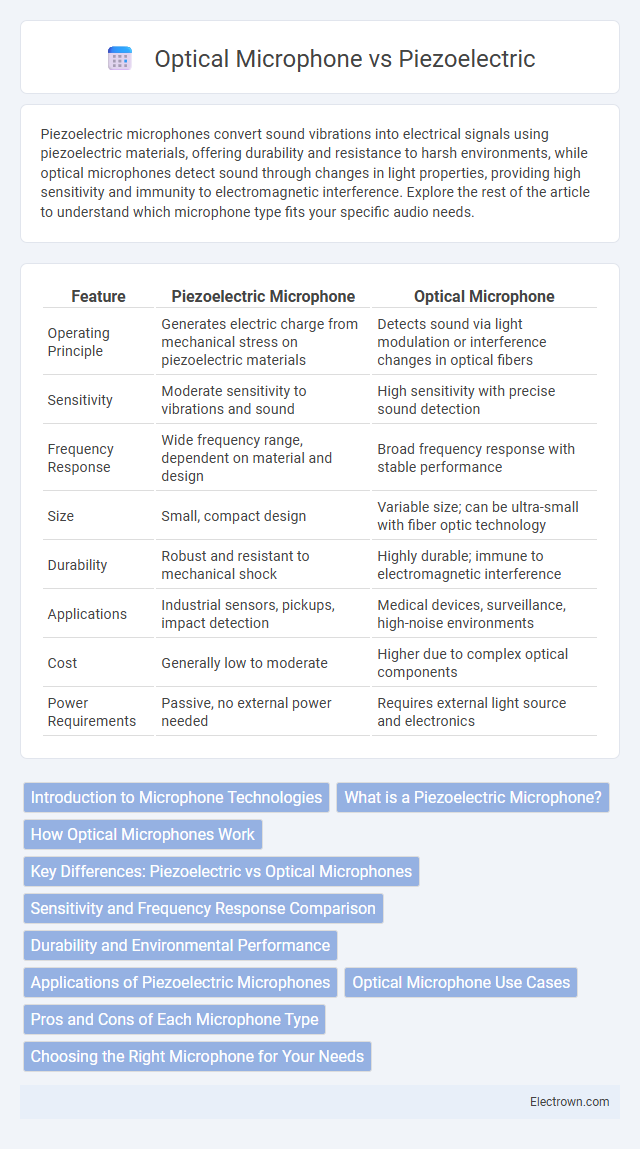Piezoelectric microphones convert sound vibrations into electrical signals using piezoelectric materials, offering durability and resistance to harsh environments, while optical microphones detect sound through changes in light properties, providing high sensitivity and immunity to electromagnetic interference. Explore the rest of the article to understand which microphone type fits your specific audio needs.
Table of Comparison
| Feature | Piezoelectric Microphone | Optical Microphone |
|---|---|---|
| Operating Principle | Generates electric charge from mechanical stress on piezoelectric materials | Detects sound via light modulation or interference changes in optical fibers |
| Sensitivity | Moderate sensitivity to vibrations and sound | High sensitivity with precise sound detection |
| Frequency Response | Wide frequency range, dependent on material and design | Broad frequency response with stable performance |
| Size | Small, compact design | Variable size; can be ultra-small with fiber optic technology |
| Durability | Robust and resistant to mechanical shock | Highly durable; immune to electromagnetic interference |
| Applications | Industrial sensors, pickups, impact detection | Medical devices, surveillance, high-noise environments |
| Cost | Generally low to moderate | Higher due to complex optical components |
| Power Requirements | Passive, no external power needed | Requires external light source and electronics |
Introduction to Microphone Technologies
Piezoelectric microphones convert sound vibrations into electrical signals using the piezoelectric effect found in materials like quartz, offering high sensitivity and durability in harsh environments. Optical microphones detect sound by measuring changes in light, often using interferometry or fiber-optic sensors, providing immunity to electromagnetic interference and enhanced precision. Both technologies serve specialized audio sensing applications where traditional dynamic or condenser microphones may be less effective.
What is a Piezoelectric Microphone?
A piezoelectric microphone converts sound vibrations into electrical signals using the piezoelectric effect, where certain materials generate voltage when subjected to mechanical stress. Unlike optical microphones that use light interference to detect sound waves, piezoelectric microphones rely on crystal or ceramic elements to capture audio, making them highly durable and suitable for harsh environments. Their compact size and resistance to moisture make them ideal for applications in industrial monitoring and musical instruments.
How Optical Microphones Work
Optical microphones capture sound by detecting vibrations through changes in light properties, such as intensity or phase, within an optical cavity or fiber. Unlike piezoelectric microphones that rely on mechanical stress generating electrical signals, optical microphones use interferometry or fiber Bragg grating to convert acoustic pressure into optical signals with high sensitivity and immunity to electromagnetic interference. Your audio setup benefits from optical microphones' precision in environments requiring minimal signal distortion and noise.
Key Differences: Piezoelectric vs Optical Microphones
Piezoelectric microphones rely on piezoelectric materials that generate electrical signals when subjected to mechanical stress, offering robustness and suitability for harsh environments. Optical microphones utilize changes in light properties, such as interference or intensity variations, to detect sound waves, providing high sensitivity and immunity to electromagnetic interference. The key differences lie in their operating principles, environmental resilience, and sensitivity, with piezoelectric types excelling in durability and optical types outperforming in precision and noise resistance.
Sensitivity and Frequency Response Comparison
Piezoelectric microphones typically exhibit high sensitivity in detecting vibrations but have a limited frequency response, often optimized for mid to high-frequency ranges. Optical microphones offer a broader frequency response with enhanced accuracy in capturing subtle sound variations, making them suitable for high-fidelity applications. Your choice between piezoelectric and optical technology depends on the specific sensitivity and frequency requirements of your audio project.
Durability and Environmental Performance
Piezoelectric microphones exhibit superior durability due to their solid-state construction, making them highly resistant to mechanical shock, moisture, and temperature fluctuations. Optical microphones excel in environmental performance by providing immunity to electromagnetic interference and operating effectively in harsh environments with extreme temperatures or high humidity. Both technologies offer robust solutions, but piezoelectric microphones are preferred for rugged applications, while optical microphones are ideal for precision sensing in electrically noisy or chemically aggressive settings.
Applications of Piezoelectric Microphones
Piezoelectric microphones are widely used in harsh environments and industrial applications due to their durability and ability to operate without external power sources. They are commonly found in acoustic emission monitoring, medical ultrasound devices, and vibration analysis systems. Their high sensitivity to mechanical stress makes them ideal for detecting structural defects and sound in challenging conditions.
Optical Microphone Use Cases
Optical microphones excel in environments requiring immunity to electromagnetic interference, making them ideal for industrial settings, medical applications, and harsh environments where precision sound detection is critical. Their ability to capture high-fidelity audio without distortion from electrical noise benefits acoustic research, aerospace, and defense industries. Your projects demanding accurate sound measurement in challenging or high-voltage areas greatly benefit from optical microphone technology.
Pros and Cons of Each Microphone Type
Piezoelectric microphones offer excellent durability and resistance to environmental factors, making them ideal for rugged applications, but they often exhibit limited frequency response and lower sensitivity compared to optical microphones. Optical microphones provide superior sensitivity and a broader frequency range, enabling high-fidelity sound capture, yet they tend to be more expensive and complex due to their reliance on advanced optical components. Choosing between piezoelectric and optical microphones depends on balancing cost, environmental resilience, and audio quality requirements for specific use cases.
Choosing the Right Microphone for Your Needs
Piezoelectric microphones excel in durability and frequency response for capturing mechanical vibrations, making them ideal for applications like acoustic instruments and industrial monitoring. Optical microphones offer superior sensitivity and low noise levels, suitable for high-fidelity sound recording and environments with electromagnetic interference. Selecting the right microphone depends on factors such as sound source, environmental conditions, and required audio quality, ensuring optimal performance tailored to specific recording needs.
Piezoelectric vs Optical Microphone Infographic

 electrown.com
electrown.com